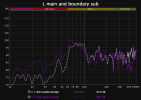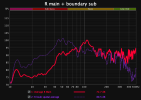- Joined
- Jun 5, 2016
- Messages
- 3,161
- Likes
- 5,350
For quite a while I've been intrigued by the "boundary woofer" concept promoted by Lyngdorf. Their marketing spiel:
To summarize, the basic concept is a 2-box synthetic speaker with the LF section remotely located in the room's front corners. Generally the MF/HF section is on or close to the wall (similar to e.g. Neumann/Genelec recommendations) but I'm not sure that's a requirement. The wrinkle is the LF-MF crossover is quite high for a remote LF section - I've read 200Hz to 400Hz in different contexts.
Has anyone tried this approach? I'm strongly considering experimenting with something like this for our formal living room, as it seems like it could potentially check the boxes of small perceived footprint but full range with smooth bass. The downside is time - if it doesn't work well I'll be stuck with it for a while due to limited time to fiddle with stuff and take good measurements. However, I'm also aware of comments by @hardisj regarding bass localization in his review of the 2.5-way JBL HDI3800, as well as by Dr. David Rich's similar observations in his AudioXpress review of an Infinity tower with a small midrange and a 500Hz specified crossover to a column of 6.5" woofers. Perhaps that can be mitigated with very steep filters?
To summarize, the basic concept is a 2-box synthetic speaker with the LF section remotely located in the room's front corners. Generally the MF/HF section is on or close to the wall (similar to e.g. Neumann/Genelec recommendations) but I'm not sure that's a requirement. The wrinkle is the LF-MF crossover is quite high for a remote LF section - I've read 200Hz to 400Hz in different contexts.
Has anyone tried this approach? I'm strongly considering experimenting with something like this for our formal living room, as it seems like it could potentially check the boxes of small perceived footprint but full range with smooth bass. The downside is time - if it doesn't work well I'll be stuck with it for a while due to limited time to fiddle with stuff and take good measurements. However, I'm also aware of comments by @hardisj regarding bass localization in his review of the 2.5-way JBL HDI3800, as well as by Dr. David Rich's similar observations in his AudioXpress review of an Infinity tower with a small midrange and a 500Hz specified crossover to a column of 6.5" woofers. Perhaps that can be mitigated with very steep filters?


